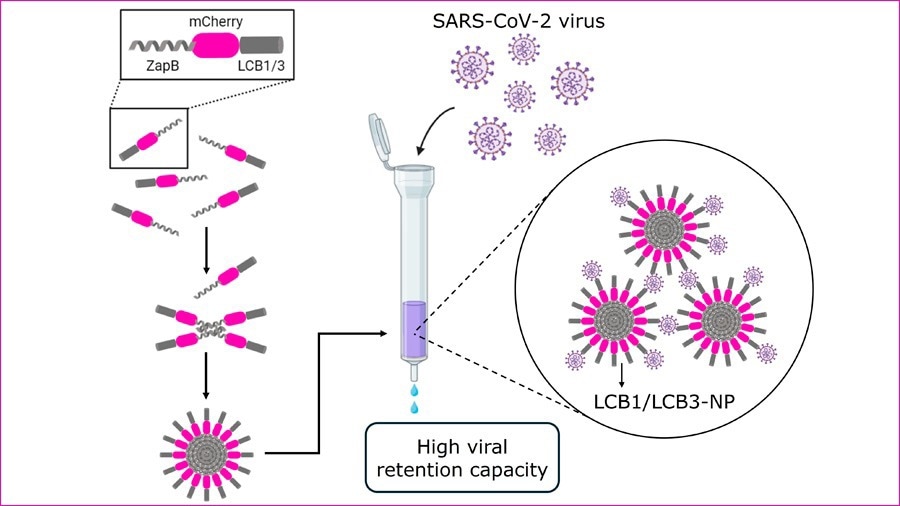Reviewed by Lexie CornerNov 7 2024
Researchers at the Institute for Biotechnology and Biomedicine at the Universitat Autònoma de Barcelona (IBB-UAB) have developed a new class of nanostructures capable of trapping and neutralizing significant amounts of SARS-CoV-2 virus particles, both in liquid solutions and on material surfaces. This research was recently published in Advanced Healthcare Materials.
 Illustration of the formation of the new nanoparticles, LCB1-NPs and LCB3-NPs, designed by the IBB-UAB researchers. Image Credit: Universitat Autònoma de Barcelona.
Illustration of the formation of the new nanoparticles, LCB1-NPs and LCB3-NPs, designed by the IBB-UAB researchers. Image Credit: Universitat Autònoma de Barcelona.
These innovative nanoparticles could be used to develop antiviral materials, such as wastewater and air filters, and may also be used to create new tests for the early detection of COVID-19. Additionally, the nanoparticles could be adapted to target other pathogens.
The study underscores the potential of these nanostructures in the production of new antiviral materials. The newly developed nanoparticles, named LCB1-NPs and LCB3-NPs, are composed of repeating units of three proteins, assembled through the self-assembly properties of one of the proteins, ZapB. In their genetic engineering approach, the researchers fused ZapB with the mCherry protein, which imparts red fluorescence to the nanoparticles.
They then incorporated the LCB1 and LCB3 proteins, which enable the nanoparticles to bind to and neutralize the SARS-CoV-2 virus. This design allowed the researchers to integrate all these functions into a single nanoparticle.
The researchers highlight the high affinity of the nanoparticles for the viral spike protein, which facilitates SARS-CoV-2 internalization into cells. This characteristic enables the nanoparticles to neutralize the virus in both liquid solutions and when immobilized on surfaces. This versatility showcases the potential of the new antiviral nanomaterial for a wide range of applications.
Each nanoparticle is composed of many LCB1 or LCB3 proteins, resulting in a high density of SARS-CoV-2 binding sites that allow each nanoparticle to bind to more than one virus. This greatly increases their potential as an antiviral material compared to other materials in which each nanostructure can only bind to one single particle of the virus.
Marc Fornt, Study First Author, Institute for Biotechnology and Biomedicine, Universitat Autònoma de Barcelona
The red fluorescence of the nanoparticles facilitates their tracking and localization, making handling easier.
In an experiment where the nanoparticles were utilized to create a virus filter, the researchers demonstrated the nanomaterial's capability to trap and neutralize significant amounts of SARS-CoV-2. Potential applications include filtering wastewater that contains secretions from COVID-19 patients to prevent contamination of water systems, as well as filtering air in sensitive environments, such as hospital wards.
Additionally, the nanoparticles could be used to develop ultra-sensitive detection tests for diagnosing the disease in its early stages, when the viral load is still low.
These new nanoparticles are also of great interest for the industrial production of antiviral materials due to the simplicity, speed, and low cost involved in making them.
Salvador Ventura, Researcher and Director, Parc Taulí Research and Innovation Institute
Salvador Ventura coordinated the study.
The modular system that generates the nanostructures allows the protein that recognizes and neutralizes SARS-CoV-2 to be replaced with proteins that target other pathogens of interest.
This flexibility provides a solid framework for the generation of new materials to combat potential emerging infectious diseases effectively and rapidly, particularly if combined with recent advances in de novo protein design.
Salvador Ventura, Researcher and Director, Parc Taulí Research and Innovation Institute
The study also involved researchers from the Parc Taulí Research and Innovation Institute (I3PT), the Catalan Institute for Research and Advanced Studies (ICREA), IrsiCaixa, the Germans Trias i Pujol Research Institute (IGTP), the CIBER thematic area of Infectious Diseases (CIBERINFEC), and the University of Vic - Central University of Catalonia (UVic-UCC).
Journal Reference:
Fornt‐Suñé, M., et al. (2024) Protein Nanoparticles for Targeted SARS‐CoV‐2 Trapping and Neutralization. Advanced Healthcare Materials. doi.org/10.1002/adhm.202402744.